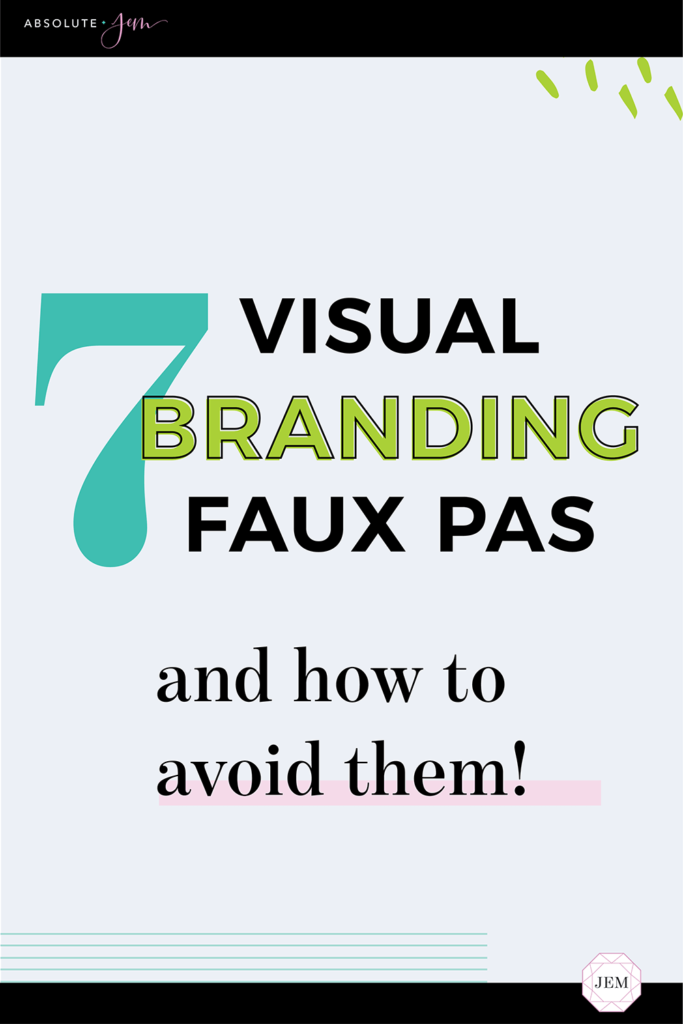Think about your brand's logo, fonts, images, and color palette. Then think of the millions of combinations of these elements, as well as the dozens of platforms you'll be using them on. From social media graphics, to presentation slides, to your website, email signature, and even product packaging...it's enough to make anyone's head spin!
With all of the possibilities comes a lot of room for error—especially if you're not a designer. But don't fret, because I've listed 7 common visual branding mistakes below along with tips on how to fix them. You've got this!

1. Inconsistency
Ignoring your brand guidelines is a really common branding mistake. But this is a huge problem considering the number 1 indicator of a strong brand is consistency. Regardless of what you choose for your logo, color palette, or ideal client, branding your business will only work if you use the same elements over and over and over again.
The goal here is to become instantly recognizable » which will eventually make you familiar » which will in turn build trust. Because consistency builds trust, right? You hire a new babysitter and you're a bit iffy at the beginning, but as she shows up day after day...always on time and on top of things...after a while you give her your credit card, pin number, front door code, and car keys without even blinking an eye. Now that's trust.
It's the same with branding. Show up for your audience with the same style, voice, colors, and fonts time and time again...and they'll eventually grow to know, like, and trust your brand.
2. Putting Design First
Your content should dictate your design—not the other way around. Figure out your messaging and your exact copy before you even start dreaming up the visuals. Then use design as a way to strategically organize the information to ensure it's eye-catching, absorbed quickly, and prioritized in order of importance.
Design gives your communication a clean, easy-to-grok visual presence—making it clear at-a-glance exactly what you want to convey. Let the design bolster the messaging by putting the copy first.
3. Logo Overload
Your logo shouldn't be doing your brand identity's heavy lifting. Sure, it's a part of your visual identity, but a strong brand should be recognizable even without the logo present. Relying too heavily on your logo is like spending so much time on the cover of a magazine that you forget to write the articles. It's a very surface level way to think about branding—and we need to dive deeper than that!
Give yourself the challenge of not using your logo on your next set of graphics. Perhaps a discreet URL at the bottom, a cute submark, a photo of your smiling face, or simply the strong use of your brand's main colors will be enough for your audience to recognize the graphic as yours. (That's the goal, right?)
Keep in mind that although your logo is something that can get your brand recognized, a logo by itself says nothing about your voice or values. So don't make it the foundation of your brand.

4. Copycat Syndrome
I'm shocked by how many imitators there are out there. SHOCKED.
It's one thing to be inspired by someone else's work—and it's a completely different thing to outright copy. Don't be a biter. Nobody wants a bootleg carbon copy of someone else.
Branding is meant to set your company apart and make you stand out in the sea of sameness. Lean into that heavily, don't second guess yourself, and just do you. It's the only way to truly attract your tribe. Can you tell I'm passionate about this topic?
5. Trend Bandwagons
Strategically incorporating design trends can keep your brand looking relevant and funky-fresh. However, please refrain from throwing your existing brand guidelines to the wind to hop on the latest design trend bandwagon. Because trends come and go, right?
Not only is this divergence confusing to your audience, but embracing the current hot design style can leave you with a brand that looks on-trend one day and dated the next. And you want your brand to stand the test of time.
Don't allow a fad to derail your branding. Be intentional. Only incorporate new elements if they align with your values and overall visual aesthetic, and remember that staying true to your vision never goes out of style.
6. Never Updating
Don't confuse being consistent for being stagnant. Your visual brand presence is a living, breathing entity—and you want your brand assets to work for you. It should feel easy and (dare I say?) enjoyable to mix and match your brand elements to create cohesive business graphics.
I highly recommend doing your own "brand audit" annually. Take a look at your existing graphics, fonts, colors, etc. Are they working well for you? Do you have enough contrasting colors to keep things interesting? Are your fonts easy to read? Does your brand make you happy and attract your ideal clients? If not, don't be afraid to make some tweaks!
7. No Brand Style Guide
I'm a HUGE proponent of having a comprehensive brand style guide for your business. This document is like a blueprint for creating your brand visuals. From what color and font combinations work best, to the style of photography to use, to examples of how to put everything together… It takes the guesswork out of your visual brand.
If you already have a strong brand identity, get a style guide together! Put all of the graphic elements in an organized PDF, but also include your brand values, voice, ideal client persona, and any rules around things like how much space should be around your logo or which color combinations are allowed.
If you need help, hire a professional designer. The investment is worth it, as having a structured and professional brand style guide to reference makes creating your graphics a no-brainer—which will save you a ton of time in the long run.